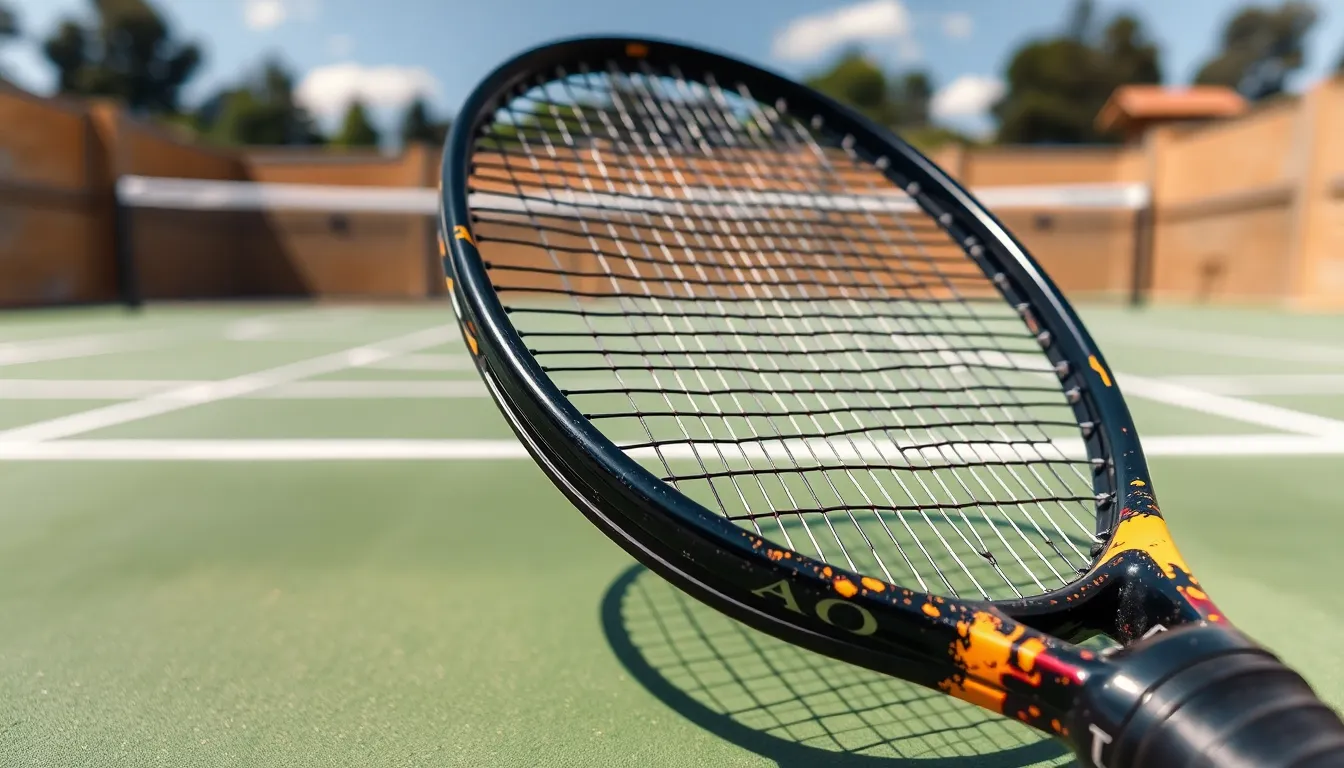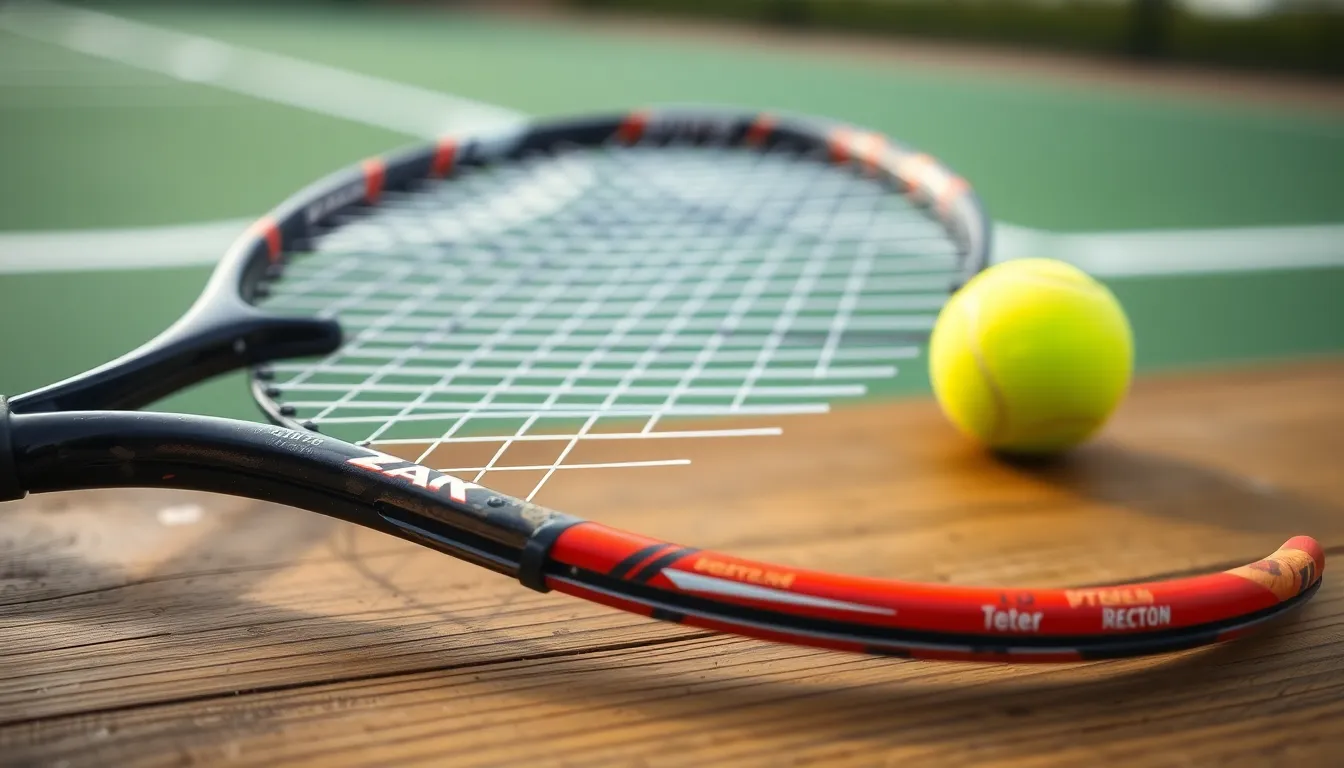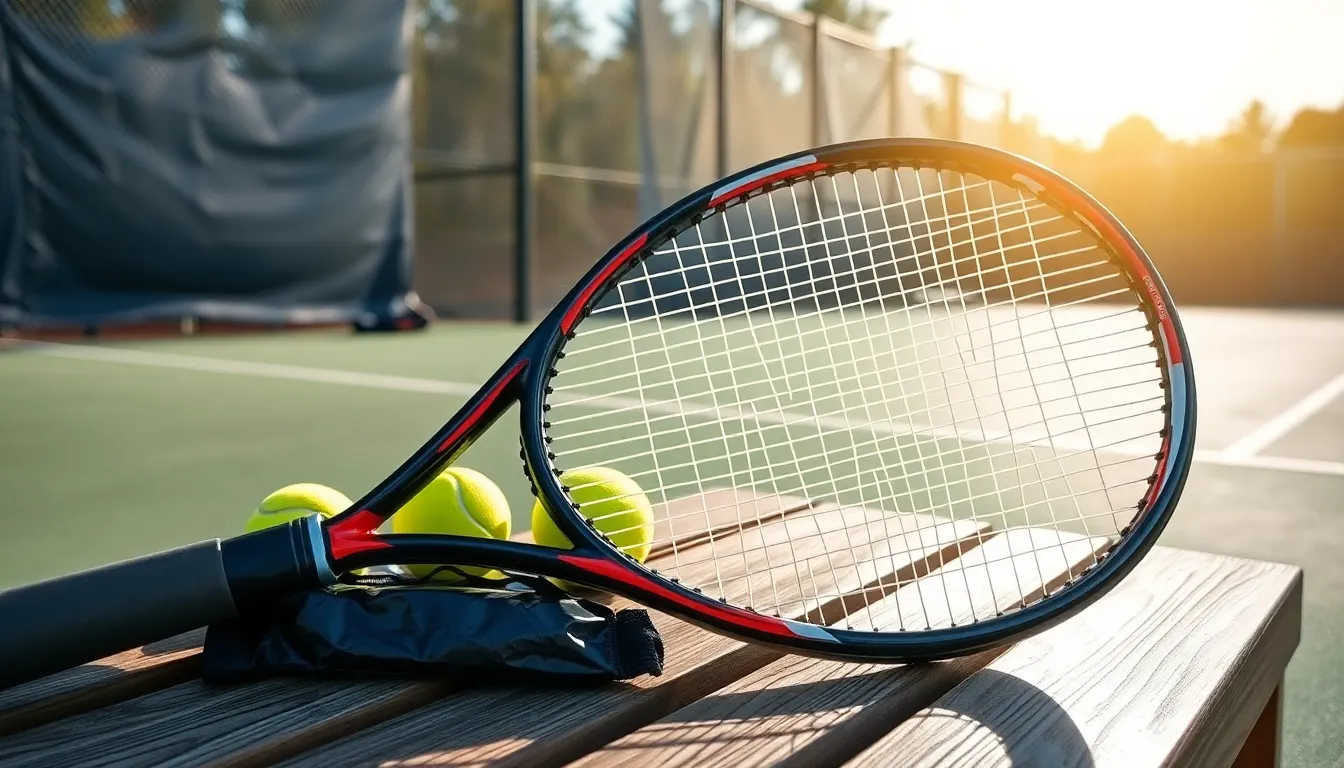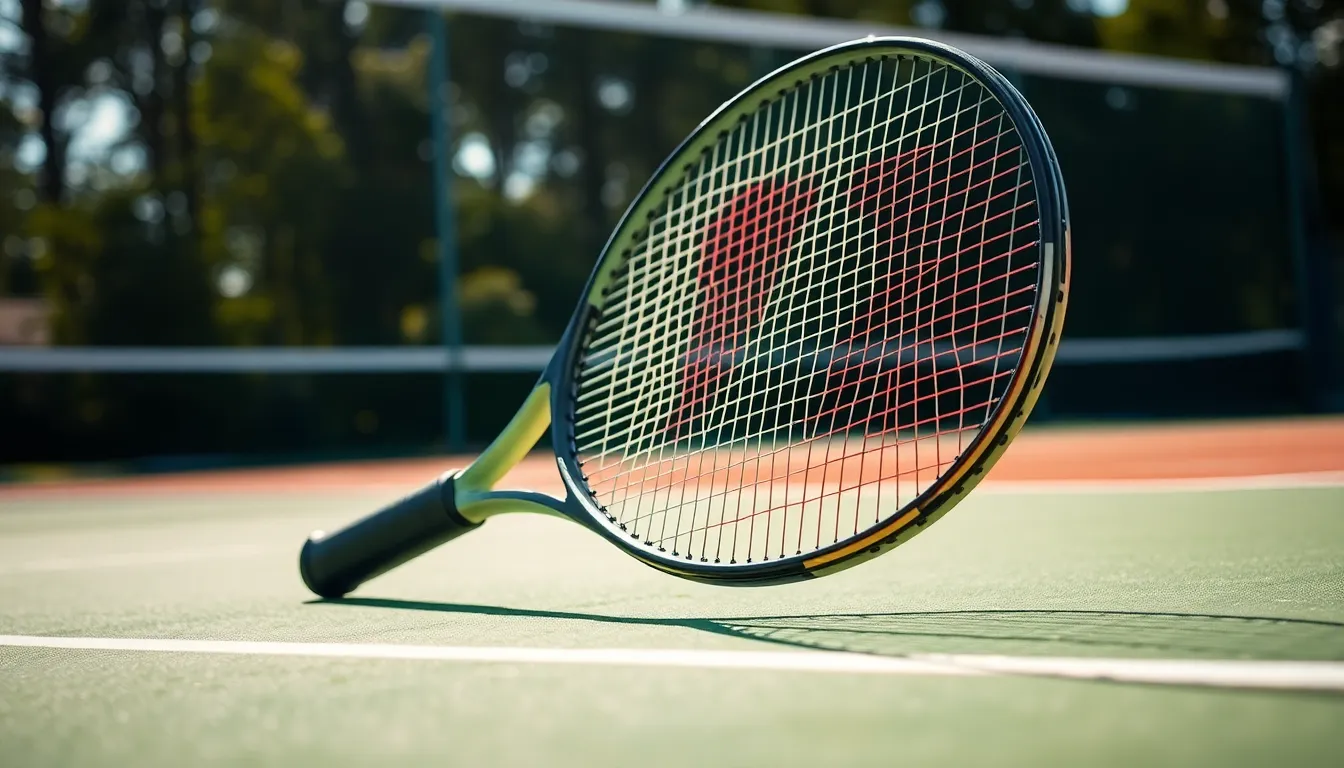Wondering how long a tennis racket lasts before you need to replace it? Your tennis racket’s lifespan directly impacts your performance on the court, yet many players overlook this crucial aspect of their equipment.
Most tennis rackets last between 2-5 years for recreational players, but several factors affect this timeline. String tension, playing frequency, storage conditions, and racket material all determine whether you’ll need a replacement sooner rather than later. Professional players often replace their rackets much more frequently—sometimes after just a few matches—while casual weekend warriors might use the same racket for many years.
The Average Lifespan of a Tennis Racket
Tennis rackets typically last 2-5 years for recreational players with regular use. But, this timeframe varies significantly based on several key factors, including playing frequency and conditions.
When I first started coaching at the University of Florida, I noticed my personal rackets would last about 3 years with daily practice sessions. Many of my students at tennisservetypes.com report similar experiences, though casual weekend players often get 5+ years from their equipment.
Pro players replace rackets much more frequently—sometimes after just one match. I’ve observed this firsthand at tournaments, where pros might go through 6-8 rackets during a single competition. They’re not necessarily broken; the players simply detect subtle changes in performance that recreational players might not notice.
The material quality directly impacts longevity. Graphite composite rackets generally last longer than aluminum frames. When coaching semi-professional players, I’ve seen how their higher-end graphite rackets maintain consistent performance for 2-3 years even though intense usage patterns.
Tennis racket materials degrade over time due to:
- UV exposure from outdoor play
- Impact stress from ball strikes
- Temperature fluctuations in storage areas
- String tension placing constant pressure on the frame
You’ll know it’s time for a replacement when you notice dead spots developing, visible frame warping, or a important decrease in power and control compared to when the racket was new.
Factors That Affect Tennis Racket Durability

Tennis racket longevity varies significantly based on several key factors that impact structural integrity and performance over time. Your racket’s lifespan depends primarily on how you use it, maintain it, and the conditions it’s exposed to throughout its service life.
Playing Frequency and Style
Playing frequency directly correlates with how quickly your tennis racket deteriorates. Frequent players who hit the court multiple times weekly typically need to replace their rackets every 6-12 months due to accumulated stress on the frame. Casual players enjoying tennis just 1-2 times weekly can expect their rackets to last 3-5 years before performance noticeably declines.
Your playing style also significantly impacts durability. Power hitters generate substantial stress on racket frames, accelerating wear compared to finesse players. The constant shock absorption from powerful groundstrokes gradually weakens the frame’s molecular structure. During my coaching sessions at the University of Florida, I’ve observed that aggressive baseliners often replace their rackets twice as frequently as control-oriented players with similar playing schedules.
Players averaging about 200 playing sessions typically reach the end of their graphite racket’s optimal performance life. For weekend warriors, this translates to approximately 4 years of use before replacement becomes advisable.
String Tension and Restringing Habits
String tension plays a crucial role in racket longevity. Higher string tensions place additional stress on the frame, gradually weakening the structure and shortening overall lifespan. Each restringing episode creates minute stress points where the strings interface with the frame grommets.
Your restringing frequency should match your playing habits. The standard guideline suggests restringing as many times annually as you play weekly. Playing twice weekly means restringing approximately twice yearly to maintain optimal performance without overstressing your frame.
Different string types affect your racket differently. Polyester strings lose tension faster than multifilament options, often necessitating more frequent restringing. This increased restringing schedule can contribute to accelerated frame wear through repeated stress cycles on the frame’s grommet system.
Storage and Maintenance Practices
Storage conditions dramatically impact your racket’s structural integrity. Proper storage in temperature-controlled environments shields rackets from damaging temperature fluctuations that can weaken carbon fiber components. Avoiding extreme heat exposure prevents frame warping and composite material degradation.
Damaged strings require immediate attention. Cutting broken strings promptly prevents continued stress on the frame fibers as uneven tension distribution can warp your racket over time. Regular inspection of grommets, bumper guards, and grip condition helps identify early signs of excessive wear.
Car trunks rank among the worst storage locations for tennis rackets. The temperature extremes inside vehicles accelerate material breakdown and potentially compromise structural integrity. I’ve witnessed many players bring in warped frames after leaving their equipment in vehicles during Florida summers, with the damage often being irreversible.
Racket covers provide essential protection during transport, preventing scratches and minor impacts that accumulate over time. Humidity control in storage areas prevents moisture-related issues like grip deterioration and potential frame weakening in composite materials.
Signs Your Tennis Racket Needs Replacement

Tennis rackets eventually wear down and lose their optimal performance capabilities. Recognizing when your racket has reached the end of its useful life helps maintain your playing quality and prevents potential injuries. Here are the key indicators that signal it’s time for a replacement.
Performance Decline Indicators
Performance issues often appear before visible damage becomes apparent. A noticeable decrease in power, accuracy, or control on the court suggests your racket frame is losing stiffness, resulting in inefficient energy transfer to the ball. Your shots may feel less crisp or responsive than they once did. Many players also report their racket feeling more “hollow” or experiencing increased vibration during impact, which can lead to discomfort or injuries like tennis elbow.
During my coaching sessions at the University of Florida, I’ve observed players struggling with their technique when in reality, their equipment was failing them. One collegiate player complained about sudden inconsistency in her backhand – after examining her three-year-old racket, we discovered it had lost important frame rigidity, affecting her shot precision. The difference was immediately noticeable when she switched to a new racket of the same model.
Visible Damage and Wear
Physical signs provide clear evidence your racket needs replacement. Cracks or microfractures in the frame compromise structural integrity and can be dangerous if they suddenly worsen during play. Damaged grommets (those protective rings where strings pass through) lead to premature string breakage and inability to maintain proper tension.
Important wear on the outer frame, particularly from scraping on hard courts, alters your racket’s balance and increases breakage risk. Any visible crack, regardless of size, means immediate replacement is necessary for your safety and performance. I’ve seen countless players at my clinics trying to extend the life of visibly damaged rackets, but this approach inevitably leads to frustration and declining results on court.
Frame warping – even subtle changes that may be hard to detect visually – dramatically affects how your racket performs. Try placing your racket on a flat surface to check if the frame sits evenly, as warping often causes wobbling. The development of “dead spots” on the string bed, where the ball doesn’t bounce with the expected responsiveness, indicates internal structural deterioration that can’t be remedied.
How to Extend Your Tennis Racket’s Life

Proper care and maintenance significantly extend your tennis racket’s lifespan, saving you money while ensuring consistent performance. Following these essential practices keeps your equipment in top condition for years beyond its expected life.
Proper Storage Techniques
Store your racket in a dry, temperate environment away from extreme conditions that accelerate deterioration. Car trunks are particularly damaging due to temperature fluctuations that can warp frames and weaken structural integrity. During my coaching days at the University of Florida, I noticed students who stored rackets in their vehicles typically needed replacements twice as often as those who didn’t.
Invest in a thermal insulation bag to protect against sunlight and humidity, especially if you live in regions with extreme weather. These specialized bags create a buffer zone that shields your racket from environmental stressors that break down materials over time.
Always keep your racket in its protective case when not in use, ensuring no heavy items press against the frame. A properly stored racket maintains its performance characteristics much longer than one left exposed to the elements or mechanical stress.
Maintenance Best Practices
Restring your racket regularly—every 3 to 6 months for frequent players—to maintain optimal string tension and prevent excess frame stress. Tight strings left too long create pressure points that gradually compromise frame integrity. During my eight years of coaching experience, I’ve observed that players who maintain consistent restringing schedules typically extend their racket life by 30-40%.
Cut broken strings immediately rather than continuing to play with them. Broken strings create uneven tension that stresses frame fibers and accelerates deterioration. This simple habit alone can add months to your racket’s useful life.
Clean your racket after each session using a soft cloth and mild cleaner or isopropyl alcohol. This removes court debris, sweat, and oils that gradually break down materials and affect grip performance. Pay special attention to the grip area where hand contact transfers oils and moisture.
Replace worn grips promptly to maintain proper handling and prevent unnecessary strain on your wrist and arm. Fresh grips not only improve comfort but also ensure you’re not altering your technique to compensate for poor grip conditions.
Avoid hitting the ground with your racket in moments of frustration. These impacts create microfractures that compromise structural integrity long before visible damage appears. Throughout my coaching career, I’ve seen countless rackets prematurely retired due to these momentary lapses in court etiquette.
Professional vs. Recreational Player Racket Longevity

Professional Players
Professional tennis players typically replace their rackets every 6 months to 1-2 years due to constant use and stress on the equipment. The demands placed on a pro’s racket are substantial, with many playing around 5 times weekly at high intensity. During my coaching years at the University of Florida, I observed several semi-professional players who needed new rackets annually even though having multiple frames in rotation.
High-level players apply greater force when striking the ball, creating micro-stress points throughout the frame with each hit. The frequent restringing at higher tensions (often 55-65 pounds) that professionals require further stresses the frame structure. Many pros restring before every match or after just a few hours of play, which gradually weakens the grommet holes and overall integrity of the racket.
Recreational Players
Recreational players enjoy significantly longer racket lifespans, typically ranging from 2 to 5+ years. The reduced frequency of play (usually 1-2 times weekly) places less cumulative stress on the frame and strings. Tennis enthusiasts who play casually maintain their equipment for extended periods because they generate less power with each stroke compared to professionals.
The restringing habits of recreational players also contribute to longer racket life. Most club-level players restring their rackets only 2-3 times yearly, minimizing the stress cycling that affects frame durability. Storage conditions matter tremendously for recreational players who might leave weeks between sessions—keeping rackets in temperature-controlled environments away from extreme heat or humidity extends their usability considerably.
Factors Affecting Longevity Differences
| Player Type | Typical Racket Lifespan | Key Factors |
|---|---|---|
| Professional | 6 months to 1-2 years | Frequent play, high string tension, powerful hits |
| Recreational | 2 to 5+ years | Occasional play, lower intensity, less restringing |
Playing style creates important longevity differences between player types. Power-focused players who hit flatter, harder shots generate more frame stress than those with control-oriented games featuring more spin. Court surfaces also impact equipment life—playing primarily on rough, abrasive courts accelerates frame wear compared to smoother surfaces.
The quality of maintenance affects longevity regardless of player level. Cutting broken strings immediately prevents warping from uneven tension. Storing rackets in protective covers between sessions shields them from environmental damage. Temperature extremes particularly affect graphite composite frames, which can develop invisible microfractures when repeatedly exposed to heat cycles in places like car trunks.
Cost Considerations: When to Replace vs. Maintain

The financial aspects of tennis racket replacement follow a predictable pattern over time. Rackets become less effective as frame stiffness naturally declines, causing noticeable losses in power and control even after restringing. This performance drop means you’re getting diminishing returns from your equipment investment.
Competitive Player Economics
Competitive players face different economic calculations than recreational ones. Investing in new rackets every 1-2 years proves more cost-effective than maintaining an overly worn racket for these athletes. The expense of frequent restringing ($20-40 per service) adds up quickly, especially when the underlying frame no longer performs optimally.
“During my coaching years at the University of Florida, I noticed our competitive players would spend $200+ annually on strings alone for rackets that were already losing their edge,” shares Azura Victoria. “After analyzing their expenses, most found buying a new $150-200 racket annually actually saved money while improving their performance.”
Recreational Player Value Calculations
Casual players operate with different cost considerations. Maintenance through occasional restringing and proper storage extends racket life significantly, making replacement every 3-5 years more economical. Your playing goals factor heavily into this decision—weekend warriors focusing on enjoyment rather than performance optimization benefit from this approach.
Many recreational players I’ve coached maintain a primary racket for serious play and keep their older models as backups, maximizing the value of their equipment. This strategy creates a natural rotation system where your backup eventually gets retired as you purchase a new primary racket.
When Repairs Make Sense
Certain issues warrant repair rather than replacement:
- Grip wear (replacement cost: $5-15)
- Cosmetic frame damage without structural compromise
- Grommet damage (replacement set: $10-20)
Frame cracks, important warping, or consistent performance issues signal the need for replacement instead of repair. The general rule: if repair costs exceed 40% of a new racket’s price, replacement typically offers better value.
Tennis racket costs vary widely ($50-300+), but investing in quality often pays dividends through extended lifespan. Mid-range rackets ($100-180) typically offer the best balance of durability and performance for most players, providing 2-4 years of reliable use with proper care.
Conclusion
Your tennis racket’s lifespan depends on how you play how well you maintain it and the quality of its materials. While pros may replace their rackets every few months recreational players can enjoy the same racket for 2-5 years with proper care.
Pay attention to performance changes like decreased power or control as these often signal it’s time for a replacement before visible damage appears. Store your racket in temperature-controlled environments avoid car trunks and invest in protective cases.
Remember that timely maintenance including regular restringing and grip replacement will extend your racket’s life saving you money in the long run. Eventually balancing performance needs with cost considerations will help you decide when it’s time to replace your trusted tennis companion.
Frequently Asked Questions
How long does a tennis racket typically last?
For recreational players, tennis rackets typically last 2-5 years. Casual weekend players might get 5+ years from their rackets, while professionals replace theirs much more frequently, sometimes after just a few matches. Factors affecting lifespan include playing frequency, string tension, storage conditions, and racket material. Graphite composite rackets generally outlast aluminum frames.
How often do professional tennis players replace their rackets?
Professional players typically replace their rackets every 6 months to 1-2 years due to high-intensity play that creates significant stress on the equipment. Some pros may even replace rackets after just a few matches. The extreme power and spin they generate accelerate frame fatigue, making frequent replacement necessary to maintain optimal performance.
What are the signs that I need to replace my tennis racket?
Key signs include decreased power, control, or accuracy; visible cracks or microfractures; damaged grommets; frame warping; and the development of “dead spots” where the ball doesn’t respond properly. You might also notice increased vibration or discomfort during play. Performance decline often occurs before visible damage appears, so pay attention to how your racket feels compared to when it was new.
Does string tension affect the lifespan of a tennis racket?
Yes, string tension significantly impacts racket longevity. Higher string tensions create more stress on the frame, potentially weakening it over time. Frequent restringing also creates stress points that can compromise frame integrity. For optimal racket preservation, use moderate string tensions and ensure professional restringing to avoid overtightening that could damage the frame.
How should I store my tennis racket to make it last longer?
Store your racket in a temperature-controlled, dry environment away from direct sunlight. Never leave it in car trunks where extreme temperatures can cause irreversible damage. Use a quality racket cover during transport to prevent scratches and impacts. Consider investing in thermal insulation bags for additional protection. Control humidity in storage areas to prevent moisture-related damage to the frame and grip.
How does playing frequency affect racket durability?
Playing frequency directly impacts racket lifespan. Frequent players (multiple times weekly) may need replacements every 6-12 months, while casual players can expect 3-5 years of use. Each impact gradually weakens the frame’s molecular structure. Additionally, aggressive playing styles generating more power and spin create greater stress on the racket, accelerating wear regardless of frequency.
Is it more cost-effective to replace or maintain a tennis racket?
For competitive players, replacing rackets every 1-2 years is often more cost-effective than paying for frequent restringing on deteriorating frames. Recreational players can economically extend racket life through proper maintenance, making replacement every 3-5 years reasonable. Minor repairs like grip or grommet replacement are worthwhile, but significant frame damage typically necessitates replacement rather than repair.
How can I extend the life of my tennis racket?
To maximize racket lifespan: store in dry, temperate environments; use protective cases; restring regularly (every 3-6 months); cut broken strings immediately; clean after each session; replace worn grips promptly; and avoid hitting the ground with your racket. Invest in thermal bags for transport and consider using racket vibration dampeners to reduce stress on the frame during play.


